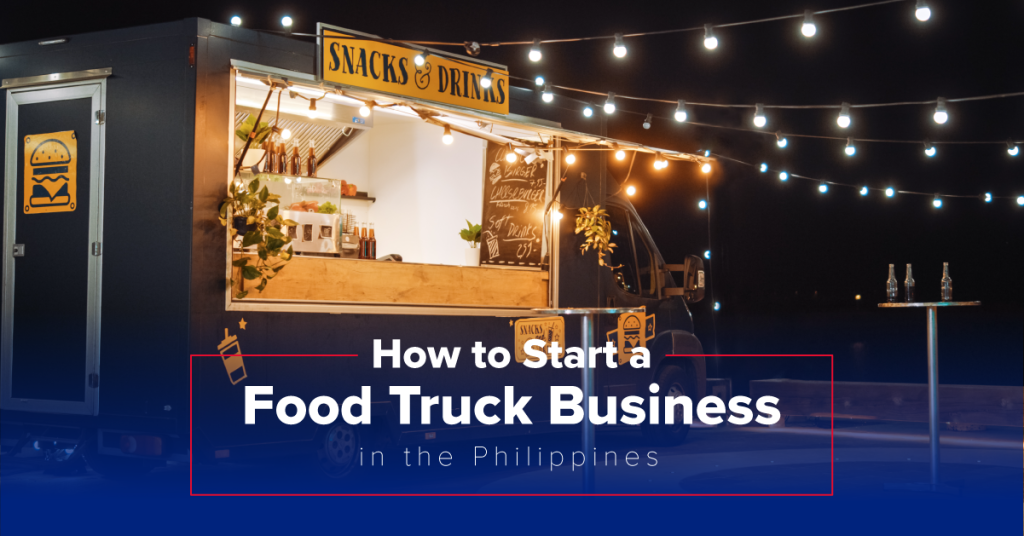Many food-loving entrepreneurs dream of opening a food truck. The allure of a mobile restaurant that can follow demand anywhere makes it attractive for anyone looking for a new investment.
However, opening a food truck business in the Philippines may still seem daunting, especially if you’re starting from scratch. For instance, you need to figure out how to finance your business to cover expenses, such as inventory, equipment, and the truck itself. This process may take months, so it’s best to start planning as early as today. Are you wondering how to start a food truck business in the Philippines? This infographic will delve into the essential considerations and provide tips to help you begin.

What is a Food Truck Business?
A food truck business sells quick-and-easy meals from a truck to customers on the streets and during events. It’s an excellent match for entrepreneurs who wish to start a restaurant but have no capital for a brick-and-mortar establishment.
Fortunately, it’s an easy enterprise to plan for—an essential step in any endeavor to set it up for success. Comprehensive business planning safeguards your food truck from financial and operational challenges. Be sure to outline goals, strategies, and processes to aid your decision-making. In turn, you’ll be able to maximize growth and take advantage of opportunities that can boost and expand your brand.
The 5 Main Components of Opening a Food Truck Business
The first step to ensure success is creating a blueprint to guide your food truck’s success. Here are five factors to consider.
1. Concept
Food stalls and karinderyas fill the country’s streets, and this tight competition could be why you’d rarely see food trucks in most areas. Unfortunately, it also means the novelty of being the only truck in the area isn’t enough. Your concept needs to be set apart from your competitors.
Study potential customers by identifying their demands, then take advantage of your business’s mobility, convenience, and cost-effectiveness to drive them in. For instance, if you plan to serve near high schools, offer a menu that’s budget-friendly yet new and exciting for the younger generations’ palate.
2. Important permits
Having proper licenses and permits is critical to avoiding penalties and legal issues, especially if you plan to operate for the long term.
The legal requirements to set up a food truck may vary depending on your location, but they generally include a barangay and mayor’s permit. You must also register under the Bureau of Internal Revenue (BIR) for taxation purposes and the Department of Trade and Industry (DTI) to file your trade name.
3. Equipment and vehicle
Of course, there’s no food truck without the truck. While it primarily serves as a transportation and kitchen, it’s also an innovative marketing tool. Owners usually design their vehicles around their concept and selling point, making it easier for customers to identify their brand.
Some owners repurpose their vehicles, so having an extra van or truck is an advantage. However, you could also hire professional vehicle supplier services to build one. If cost is an issue, online loans can help finance your truck if you need a financial boost.
Lastly, it would be best to consider the kitchen layout. Given trucks’ limited space, you must prioritize safety and efficiency. Kitchen equipment should also be small to fit into the vehicle but functional enough to survive heavy use. Consider their weight since bulky, heavy stoves and freezers will only consume valuable floor area and exhaust the engine when driving.
4. Location plan
While food trucks are mobile, it doesn’t mean you can just start selling anywhere. First, it’s essential to evaluate the location’s marketability. Are there enough potential customers in the area? A discrepancy between your product and the area’s demographics is problematic. For instance, you might find it tough to sell hot stew near beaches where other products, like fried and cold food, might sell better.
Legal compliance with local regulations is another critical consideration. Say, you’re selling beer with meals. Does the city allow public consumption of alcohol? If not, you might receive penalties for violating ordinances, which may impact your enterprise’s standing with the local government and customers.
5. Marketing planning and solution
Like any other business, marketing strategies are an essential part of operations. For starters, you could give the truck a distinct look to pique people’s interest. Then, they might advocate for your brand through word-of-mouth if they like your food.
You could also leverage social media marketing to get the word out and post photos of your truck and food to spark conversations and improve visibility. You can also tap into influencer marketing to advertise your brand to a big following. Either way, carefully planning marketing tactics can drive in customers from anywhere, especially if you frequently change locations.
5 Essential Steps in Starting a Food Truck Business
It’s time to put your plans into action. These steps will ensure your food truck’s successful launch and minimize any hitches during operations.
1. Make a business plan
The first step in any undertaking is to plan. Start your food truck by creating a business plan to reduce guesswork and identify ways to maximize emerging opportunities. Consider your enterprise’s feasibility, particularly on the following factors:
- Cost
Determine budget, resources, suppliers, expenses, and other financial factors influencing your cost-revenue ratio. Start by determining your starting capital and how much you expect to return. Remember, the goal isn’t only to make money but also to do so efficiently without sacrificing service quality.
- Scalability
There may come a time when you have built enough revenue to support expansion. Don’t restrict yourself to a tiny spot on the street—identify opportunities to grow by analyzing your potential development. For instance, many food brands set up a franchise in other locations to tap into larger markets and increase profits, which is something you may consider.
2. Conduct proper market research
Identify your target market segment to determine how your food matches customer preferences and budgets. A discrepancy between products and target market may invite little to no customer support, wasting your brand’s potential.
An excellent way to research your market is by segmenting the target area’s population based on age, employment, income, and mobility. For example, you could assume high-income Gen Z professionals with cars have different food preferences from baby boomer retirees around parks. Identify which segment may be your long-term customers, then adjust your operations to match their demands.
3. Adjust the menu to market preferences
After identifying your target market segment, determine their food preferences, which you may crowdsource or research. Next, list everything you’ve collected but ensure they align with the food truck’s concept. Then, include the easiest and least expensive meal on your menu.
Suppose you specialize in Japanese food and are targeting university students. You could serve low-cost, on-the-go dishes, such as chicken katsu, teriyaki bowls, and stir-fry noodles, which accommodate their limited budgets yet are quick and easy to consume between classes.
4. Choose a high-traffic location
Again, location is a critical consideration. Even the most affordable, convenient, and high-quality enterprise might fail without an optimized setting. Remember, your primary customers would be on foot, so pick a wide and busy street or sidewalk to park on.
You could also look for large festivals and events and reserve a slot to leverage their high foot traffic. For instance, music festivals typically demand products like nachos, popcorn, and beverages. Ultimately, focus on being accessible and visible to catch people’s attention amid busy crowds and competing food places.
5. Evaluate your performance
The food service industry is highly volatile. You might perform well one day but suffer sudden losses the next, so taking steps to avoid stagnation is crucial—a goal achievable by evaluating your performance regularly.
Conduct frequent SWOT analyses to analyze wins and losses and identify advancement opportunities. You could also collect customer feedback through comment forms, social media reviews, or asking buyers directly, which is an excellent way to evaluate your service quality from your stakeholders’ perspective.
Frequently Asked Questions
For more information about starting a food truck in the Philippines, let’s answer a few burning questions below.
1. Do food trucks need permits in the Philippines?
Yes, food trucks need permits in the Philippines to operate legally. The minimum requirements are barangay and mayor’s permits from your location and registrations from the BIR and DTI.
2. How much does a food truck make in the Philippines?
Food trucks make a profit margin of about 7–8%, which means you’ll need to serve a lot of customers to make significant profits.
3. How much investment do you need for a food truck?
Investing in a food truck can be cheap but may also reach upwards of ₱200,000, depending on the cost of permits, vehicle purchase, utilities, gas, and ingredients. However, you can avoid paying a large sum out-of-pocket by taking out a loan for a financial boost.
4. Is owning a food truck profitable?
Owning a food truck is profitable with proper business planning. However, as with any enterprise, it has challenges like competition, customer support, and rapidly changing food trends, which can impact revenue.
5. What makes a food truck successful?
A successful food truck offers budget-friendly and high-quality products in a great location with high foot traffic.
6. What food sells best in food trucks?
Food that customers can easily consume sells well in food trucks, including lunch bowls, skewers, snacks, and desserts.
Leverage Mobility and Affordability with Food Trucks
Compared to other food establishments in the country, you won’t see as many food trucks on the street as karinderyas and food carts, demonstrating the highly competitive nature of the food service industry. However, it doesn’t mean standing out is impossible. Given its novelty, this enterprise is a potential gold mine—you only need to plan and operate effectively to turn it into your ticket to success.
Are you looking for a truck loan to open a food truck? Then, we’ve got you covered. AsiaLink Finance, the leading financing company in the Philippines, offers convenient and accessible loans with competitive interest rates to help you succeed. Apply now or contact us to learn more!






